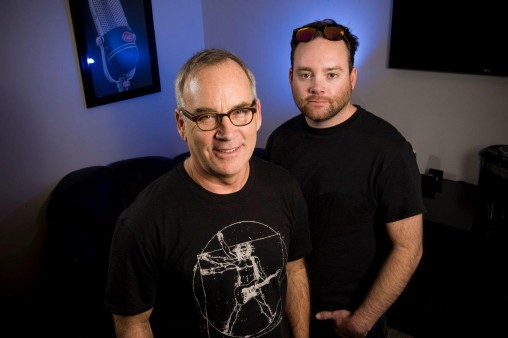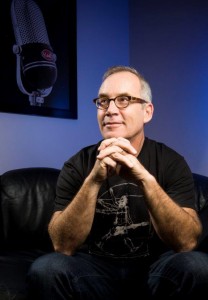
Wright State graduate Steve Hampton ’80, left, and his son Will recently finished installing a professional-level recording studio for music students for use in Schuster Hall. (Photos by Erin Pence)
Wright State University now has a state-of-the art, professional-level recording studio thanks to noted Hollywood composer and Wright State alumnus Steve Hampton ’80.
The studio, which is housed in Benjamin and Marian Schuster Hall in the Creative Arts Center, will be available to students to record their performances and will also be used by students seeking a certificate in recording technology. Hampton and his son Will recently finished installing the studio.
“In the United States, there are a lot of universities that have recording-studio programs, but they are nothing like ours,” said Randall Paul, professor and director of Wright State’s School of Music. “We have something that is completely special.”
The idea for the recording studio was born a few years ago as part of the $4.2 million concert hall renovation, which created nearly perfect acoustics.
“When we realized how sound-insulated we had made Schuster Hall, it occurred to us that we could actually use it as a recording studio,” said Paul. “Then it dawned on us that we had a really great opportunity here to have something no one else has.”
Hampton designed the studio, bought some sound and recording equipment and about a year ago installed it in booth space at the rear of the concert hall. He and his son then did all the wiring and built the patch bays.
“I’m the guy cutting all the wires, stripping them out, modifying, putting all of these different connectors and various pieces of hardware together,” said Will Hampton, a professional audio recording engineer. “The patch bay is a panel that has all of these little points. It’s the brain of the studio.”
In January, the Hamptons returned to Wright State and installed a new, upgraded array of microphones called a Decca Tree. This microphone system was developed in the 1950s at Decca Records in England.
“It’s a good way to record an orchestra,” Steve Hampton said. “And for concert hall music, microphones are super important so you get really accurate, clear, clean representation of what you’re hearing.”

Steve Hampton graduated from Wright State in 1980 in music theory and composition, currently works in Los Angeles as a composer primarily for television.
Hampton has created a first-class signal chain, with Nuemann and Sennheiser microphones feeding into Class A preamplifiers and then into digital recording software called Pro Tools, the industry standard. The system is also designed to archive and back up recordings so that nothing is lost.
“It’s small, but it’s definitely a Cadillac,” Hampton said of the system. “We tried to keep it pretty simple and streamlined, but high-end.”
Students will be able to record their performances and put them on their resumes for graduate school or for orchestral and other jobs.
Graduates of the certificate program would be trained audio engineers, qualified to work professionally in recording studios. They could also edit music for television and film.
“Musicians need good recordings, and recording engineers need good musicians,” said Paul. “So the two just come together beautifully.”
Paul said the studio may also be available to outside recording artists. During the day, the hall would be used for rehearsals, performances and student recording. But at night it could be used as a working recording studio.
Paul says the certificate program will come first, with perhaps a minor and a major at a later time.
“We will always be extremely selective. It’s always going to be the highest quality,” he said. “And we want to have an internship relationship with Steve and his studio. That’s the appeal — to not only study and learn it but to intern with a famous professional.”
Hampton, who lives in Los Angeles, currently works as a composer primarily for television. He has composed scores for several series, including “Just Shoot Me” and “Last Comic Standing.” He currently composes music for the Discovery Channel show “Alaska: The Last Frontier.”
Hampton has also composed commercial music for such notable clients as Walgreens, Nike and Toyota. He recently composed the score for a General Electric spot that won a silver medal in the London International Awards, which honor excellence in music, sound and other areas.
Hampton got into music by accident when as a 12-year-old boy he wandered into a building on a Navy base in Norfolk, Virginia, where a band was rehearsing.
“It was one of those moments where I said, ‘This is the coolest thing I’ve ever heard or seen in my life,’” he recalled.
So Hampton used his paper route money to buy a guitar and small amplifier and would sit in his bedroom every day after school learning chords.
He was later accepted into the classical guitar program at Wright State. During his senior year, he and his rock band were playing in Alabama, and they went into a recording studio after hours. It was Hampton’s first look at a control room.
“I was just amazed at the whole recording process,” he said.
After graduating from Wright State in 1980 in music theory and composition, Hampton and his wife moved to Anchorage, Alaska, where for four years he played acoustic guitar in local clubs, wrote songs for ad agencies and learned how to engineer in local recording studios.
Hampton says it was at Wright State where he learned how to learn.
“And I learned how to learn fast and efficiently,” he said. “Especially for composing; everything is on a deadline.”

 Milling around
Milling around  Wright State recognizes Nursing Professor Kim Ringo for advancing international student success
Wright State recognizes Nursing Professor Kim Ringo for advancing international student success  Wright State honors graduating students for distinguished doctoral dissertations
Wright State honors graduating students for distinguished doctoral dissertations  Top 10 Newsroom videos of 2025
Top 10 Newsroom videos of 2025  Museum-quality replica of historic Hawthorn Hill donated to Wright State
Museum-quality replica of historic Hawthorn Hill donated to Wright State 